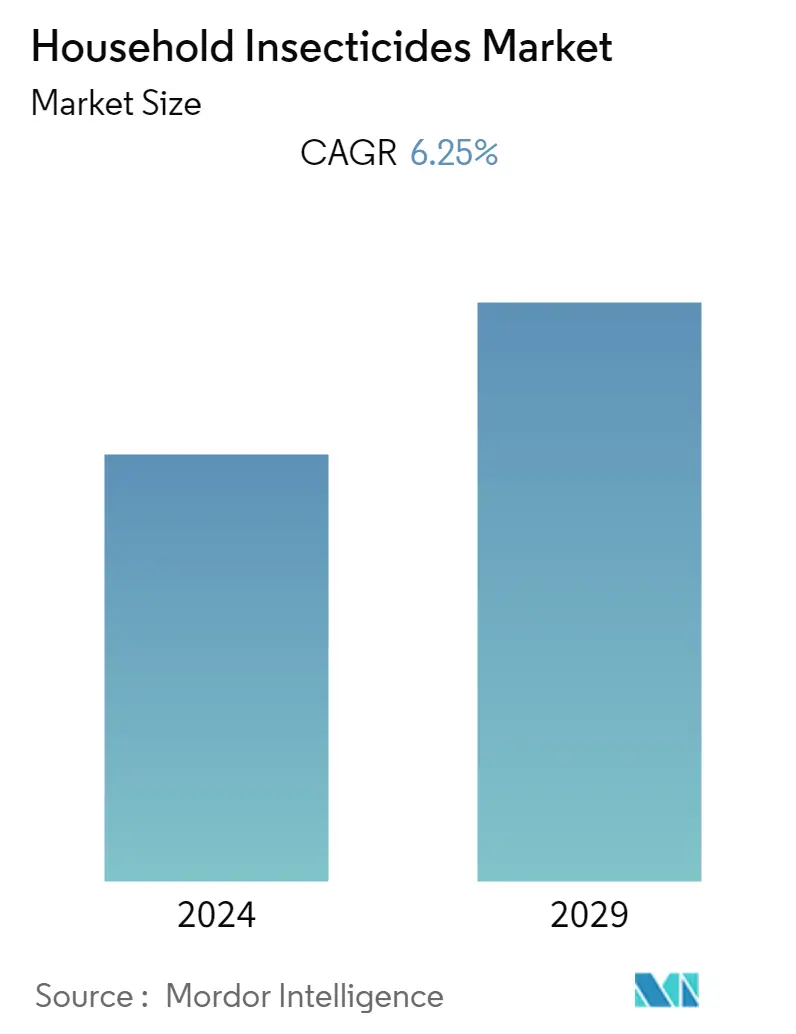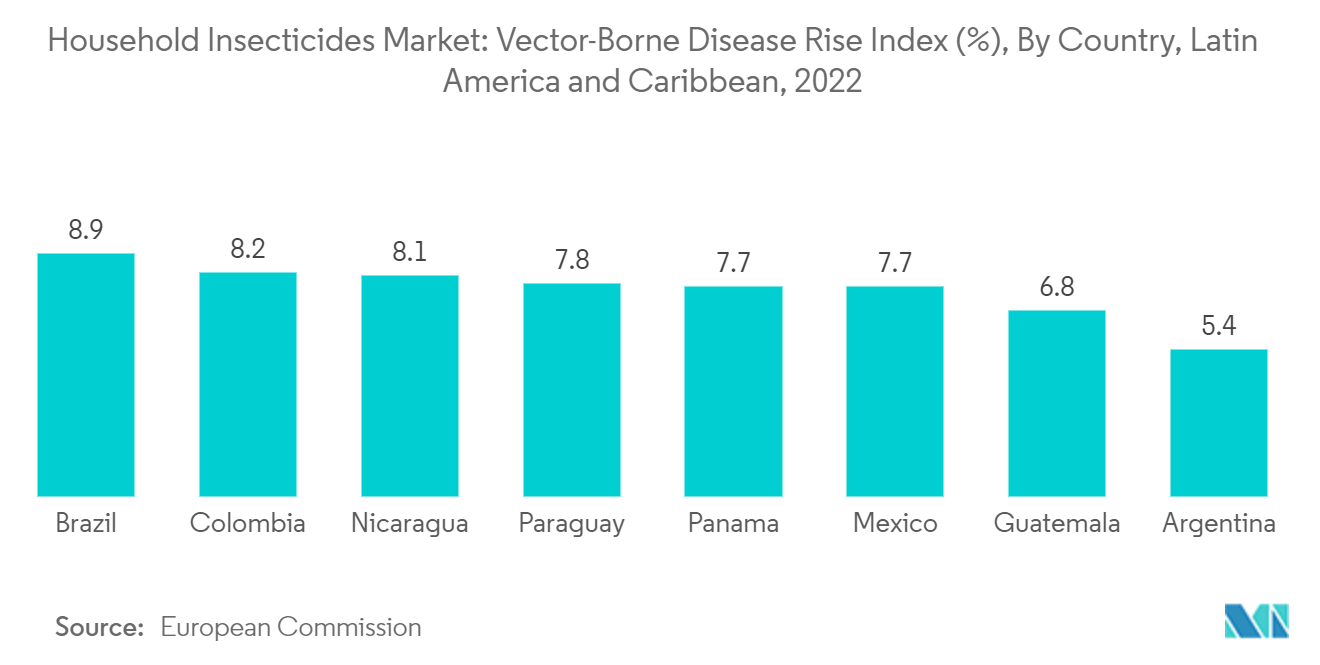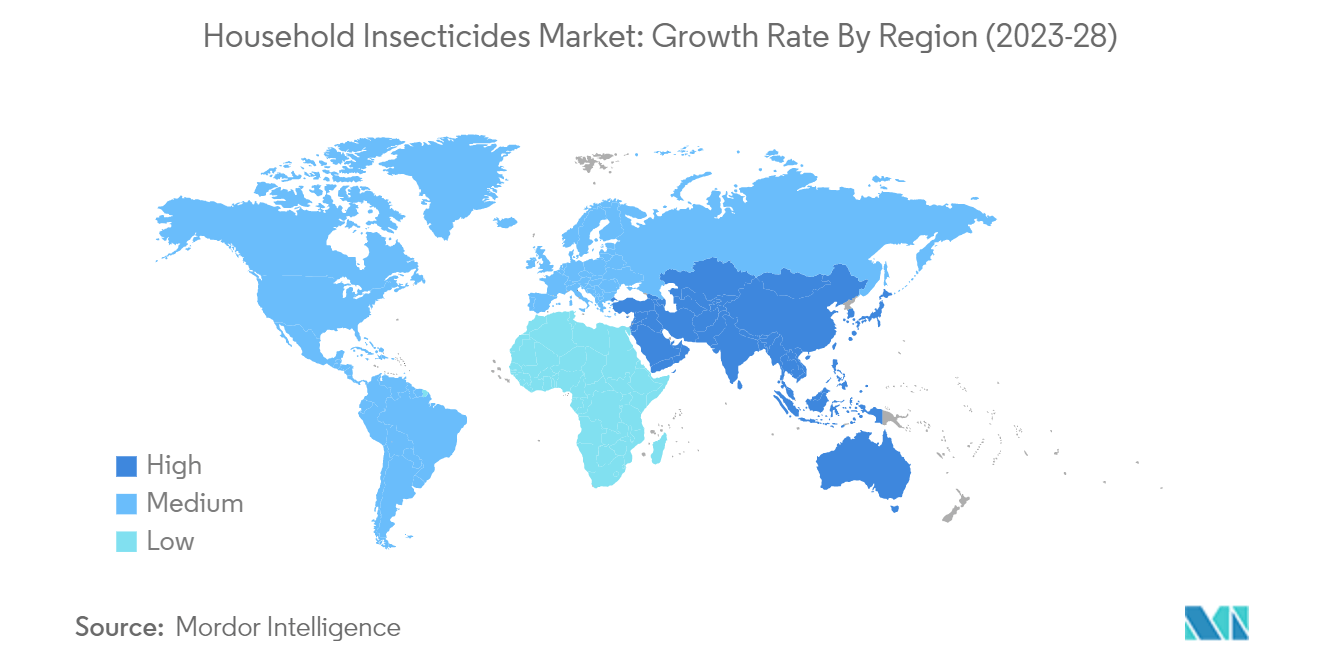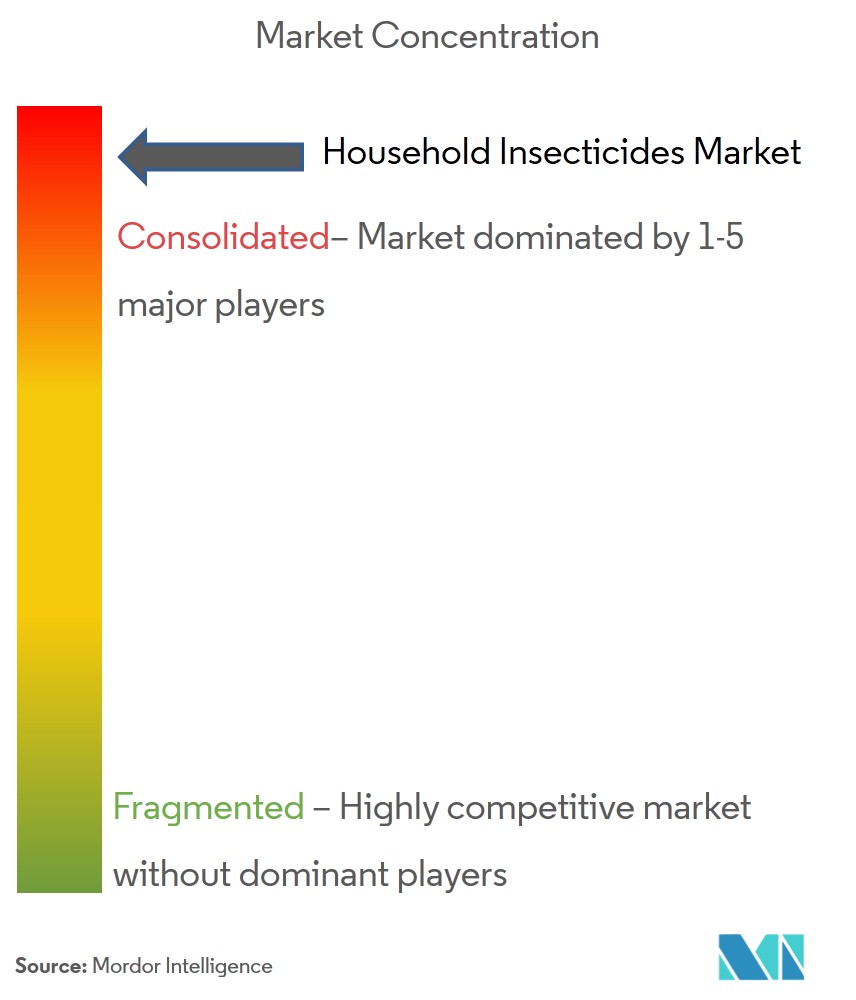Household Insecticides Market Size

| Study Period | 2019 - 2029 |
| Base Year For Estimation | 2023 |
| CAGR | 6.25 % |
| Fastest Growing Market | Asia Pacific |
| Largest Market | Asia Pacific |
| Market Concentration | High |
Major Players.webp)
*Disclaimer: Major Players sorted in no particular order |
Household Insecticides Market Analysis
The Household Insecticides Market size is estimated at USD 17.24 billion in 2023, and is expected to reach USD 23.34 billion by 2028, growing at a CAGR of 6.25% during the forecast period (2023-2028).
- Increased threats due to communicable diseases such as malaria and an increased emphasis on the control of insect vectors by local and national government bodies are expected to drive the market in the forecast period.
- To cater to the needs of household consumers, companies in the market are increasingly providing convenience through products that are easy to use and require minimal effort. In addition, there is a growing trend towards safer and more environment-friendly household insecticides. This has led to an increase in the usage of synthetic pyrethroids, which are considered to be safer than traditional insecticides.
- One of the major challenges facing the market is the emergence of insect resistance among insects. This has led to the development of new and innovative insecticides that are more effective and have a longer residual effect. Another challenge is the negative impact of insecticides on the environment and human health. This has led to increasing demand for more sustainable and eco-friendly solutions. Therefore, with an increasing focus on safer and more sustainable products, the industry is expected to grow during the forecast period, coupled with increasing new innovations and solutions aimed at improving efficiency and effectiveness in controlling insect vectors.
Household Insecticides Market Trends
Rising Prevalence of Insect-borne Diseases
- Insects, particularly mosquitoes and ticks, are responsible for the transmission of many diseases, such as malaria, dengue fever, Zika virus, Lyme disease, and West Nile virus, among others. There are several reasons for the rising prevalence of insect-borne diseases, including climate change, urbanization, and increased global travel.
- The global urban population is becoming more health-conscious, and people are becoming more aware of the risks of mosquito bites. Furthermore, as the number of diseases caused by mosquitoes increases in developing countries, the rural population is becoming increasingly concerned about health and hygiene.
- Additionally, the increase in air conditioning units and other appliances that hold water can provide breeding sites for mosquitoes.
- Climate change is one of the primary reasons for the increased prevalence of insect-borne diseases. As global temperatures rise, the geographic range of many insect vectors expands. For instance, the Asian tiger mosquito, a vector for dengue and Zika viruses, has spread to new parts of Europe and the Americas due to warming temperatures. Therefore, the rising prevalence of insect-borne diseases is a complex issue caused by a combination of factors.

Asia Pacific Dominates the Market
- The Asia-Pacific region is experiencing rapid urbanization and an increasing population, which has resulted in a rise in demand for household insecticides. With more people living in close proximity to each other, the chances of insect infestations and the spread of diseases increase. Additionally, the rising disposable incomes of people in this region have led to increased spending on household products, including insecticides.
- Vector-borne diseases like dengue fever are also a major concern in the Asia-Pacific region. Dengue fever is a mosquito-borne viral disease that has become a significant public health concern in many countries in this region. The rising incidence of dengue fever and other vector-borne diseases has led to increased awareness about the importance of keeping households insect-free. This has driven the demand for household insecticides in the region.
- Governments in the Asia-Pacific region have also taken steps to address the problem of vector-borne diseases. They have implemented awareness campaigns to educate people about the importance of keeping their homes insect-free and have also introduced regulations to ensure insecticides are used safely and effectively. Overall, the growth of the household insecticides market in the Asia-Pacific region is driven by a combination of factors, including population growth, urbanization, rising disposable incomes, and concerns over vector-borne diseases. The market is expected to continue to grow in the forecast period.

Household Insecticides Industry Overview
The household insecticides market is consolidated, with major players accounting for the majority of the share of the market. FMC Global Specialty Solutions, Godrej Consumer Products Limited, S.C Johnson & Son, Johnson and Johnson, Spectrum Brands, Natural INSECTO Products Inc., and others are some of the major players in the industry. Product innovation is a go-to-market strategy adopted by firms to increase market penetration in rural areas and consumption growth in urban areas. The players are also heavily focusing on developing integrated marketing communications like television, newspapers, Internet, and radio advertisements to increase sales.
Household Insecticides Market Leaders
-
FMC Global Specialty Solutions
-
Godrej Consumer Products Ltd
-
S. C. Johnson & Son, Inc.
-
Spectrum Brands, Inc.
-
Natural INSECTO Products, Inc.
*Disclaimer: Major Players sorted in no particular order

Household Insecticides Market News
- February 2023: Godrej Consumer Products Ltd launched two homegrown innovations; a low-cost liquid mosquito repellent device and a no-gas instant mosquito-kill spray. The products were launched in the presence of experts from the National Center for Vector-Borne Diseases Control (NCVDC), Malaria no more India, Fortis Hospital, Noida, among others.
- May 2022: Spectrum Brand Holdings Inc., the maker of Cutter insect repellant, changed the visual identity of the product, which includes a new logo, redesigned packaging labels, and a more informative website. Furthermore, distinct elements on brand packaging highlight key product benefits such as length of protection, N, N-Diethyl-meta-toluamide (DEET) percentages, and DEET-free alternatives. This will enable shoppers to locate the products which suit their needs.
Household Insecticides Market Report - Table of Contents
1. INTRODUCTION
- 1.1 Study Assumptions and Market Definition
- 1.2 Scope of the Study
2. RESEARCH METHODOLOGY
3. EXECUTIVE SUMMARY
4. MARKET DYNAMICS
- 4.1 Market Overview
- 4.2 Market Drivers
- 4.3 Market Restraints
-
4.4 Industry Attractiveness - Porter's Five Forces Analysis
- 4.4.1 Bargaining Power of Suppliers
- 4.4.2 Bargaining Power of Buyers
- 4.4.3 Threat of New Entrants
- 4.4.4 Threat of Substitute Products
- 4.4.5 Intensity of Competitive Rivalry
5. MARKET SEGMENTATION
-
5.1 Insect Type
- 5.1.1 Mosquitoes & Flies
- 5.1.2 Rats & other Rodents
- 5.1.3 Termites
- 5.1.4 Bedbugs & Beetles
- 5.1.5 Other Insect Types
-
5.2 Chemical Type
- 5.2.1 Synthetic
- 5.2.1.1 N, N-Diethyl-Meta-Toluamide
- 5.2.1.2 Hydroxyethyl Isobutyl Pieridine Carboxylate
- 5.2.1.3 Other Chemical Types
- 5.2.2 Natural
- 5.2.2.1 Citronella Oil
- 5.2.2.2 Geraniol Oil
- 5.2.2.3 Other Natural Oils
-
5.3 Form
- 5.3.1 Dust and Granules
- 5.3.2 Liquids
- 5.3.3 Aerosol Sprays
- 5.3.4 Other Forms
-
5.4 Geography
- 5.4.1 North America
- 5.4.1.1 United States
- 5.4.1.2 Canada
- 5.4.1.3 Mexico
- 5.4.1.4 Rest of North America
- 5.4.2 Europe
- 5.4.2.1 Germany
- 5.4.2.2 Spain
- 5.4.2.3 United Kingdom
- 5.4.2.4 France
- 5.4.2.5 Italy
- 5.4.2.6 Russia
- 5.4.2.7 Rest of Europe
- 5.4.3 Asia-Pacific
- 5.4.3.1 India
- 5.4.3.2 China
- 5.4.3.3 Singapore
- 5.4.3.4 Japan
- 5.4.3.5 Australia
- 5.4.3.6 Rest of the Asia-Pacific
- 5.4.4 South America
- 5.4.4.1 Brazil
- 5.4.4.2 Argentina
- 5.4.4.3 Rest of South America
- 5.4.5 Africa
- 5.4.5.1 South Africa
- 5.4.5.2 Rest of Souh Africa
6. COMPETITIVE LANDSCAPE
- 6.1 Most Adopted Strategies
- 6.2 Market Share Analysis
-
6.3 Company Profiles
- 6.3.1 Amplecta AB
- 6.3.2 FMC Global Specialty Solutions
- 6.3.3 Godrej Consumer Products Ltd
- 6.3.4 Natural INSECTO Products, Inc.
- 6.3.5 Nicols International Sa.
- 6.3.6 S.C. Johnson & Son
- 6.3.7 Shogun Organics
- 6.3.8 Spectrum Brands Holding
- *List Not Exhaustive
7. MARKET OPPORTUNITIES AND FUTURE TRENDS
** Subject To AvailablityHousehold Insecticides Industry Segmentation
Home insecticides are products designed to kill or control insects within and around the home. They are typically used to control common household pests such as ants, roaches, spiders, and flies. Home insecticides come in various forms, such as sprays, baits, powders, and traps, and are formulated with different active ingredients that target specific types of insects.
The household insecticides market is segmented by insect type into mosquitoes & flies, termites, bedbugs & beetles, and other insect types. By chemical type into synthetic and natural. By form into dust and granules, liquids, aerosol sprays, and other forms. By geography into North America, Asia-Pacific, Europe, South America, and Africa.
The market sizing has been done in value terms in USD for all the abovementioned segments.
| Insect Type | Mosquitoes & Flies | |
| Rats & other Rodents | ||
| Termites | ||
| Bedbugs & Beetles | ||
| Other Insect Types | ||
| Chemical Type | Synthetic | N, N-Diethyl-Meta-Toluamide |
| Hydroxyethyl Isobutyl Pieridine Carboxylate | ||
| Other Chemical Types | ||
| Chemical Type | Natural | Citronella Oil |
| Geraniol Oil | ||
| Other Natural Oils | ||
| Form | Dust and Granules | |
| Liquids | ||
| Aerosol Sprays | ||
| Other Forms | ||
| Geography | North America | United States |
| Canada | ||
| Mexico | ||
| Rest of North America | ||
| Geography | Europe | Germany |
| Spain | ||
| United Kingdom | ||
| France | ||
| Italy | ||
| Russia | ||
| Rest of Europe | ||
| Geography | Asia-Pacific | India |
| China | ||
| Singapore | ||
| Japan | ||
| Australia | ||
| Rest of the Asia-Pacific | ||
| Geography | South America | Brazil |
| Argentina | ||
| Rest of South America | ||
| Geography | Africa | South Africa |
| Rest of Souh Africa |
Household Insecticides Market Research FAQs
What is the current Household Insecticides Market size?
The Household Insecticides Market is projected to register a CAGR of 6.25% during the forecast period (2024-2029)
Who are the key players in Household Insecticides Market?
FMC Global Specialty Solutions, Godrej Consumer Products Ltd, S. C. Johnson & Son, Inc., Spectrum Brands, Inc. and Natural INSECTO Products, Inc. are the major companies operating in the Household Insecticides Market.
Which is the fastest growing region in Household Insecticides Market?
Asia Pacific is estimated to grow at the highest CAGR over the forecast period (2024-2029).
Which region has the biggest share in Household Insecticides Market?
In 2024, the Asia Pacific accounts for the largest market share in Household Insecticides Market.
What years does this Household Insecticides Market cover?
The report covers the Household Insecticides Market historical market size for years: 2019, 2020, 2021, 2022 and 2023. The report also forecasts the Household Insecticides Market size for years: 2024, 2025, 2026, 2027, 2028 and 2029.
Household Insecticides Industry Report
Statistics for the 2024 Household Insecticides market share, size and revenue growth rate, created by Mordor Intelligence™ Industry Reports. Household Insecticides analysis includes a market forecast outlook to 2029 and historical overview. Get a sample of this industry analysis as a free report PDF download.



